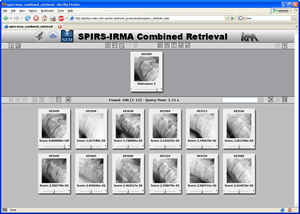Project Member(s): Sameer Antani, Rodney Long, Leif Neve
 There is a significant increase in the use of medical images in clinical medicine, disease research, and education. While the literature
lists several successful systems for content-based image retrieval and image management methods, they have been unable to make significant
inroads in routine medical informatics. This can be attributed to: (i) the challenging nature of medical images, (ii) need for specialized
methods specific to each image type and detail, (iii) lack of advances in image indexing methods, and (iv) lack of a uniform data and
resource exchange framework between complementary systems. Most systems tend to focus on varying degrees of the first two items, making
them very versatile in a small sampling of the variety of medical images but unable to share their strengths.
There is a significant increase in the use of medical images in clinical medicine, disease research, and education. While the literature
lists several successful systems for content-based image retrieval and image management methods, they have been unable to make significant
inroads in routine medical informatics. This can be attributed to: (i) the challenging nature of medical images, (ii) need for specialized
methods specific to each image type and detail, (iii) lack of advances in image indexing methods, and (iv) lack of a uniform data and
resource exchange framework between complementary systems. Most systems tend to focus on varying degrees of the first two items, making
them very versatile in a small sampling of the variety of medical images but unable to share their strengths.
We propose to overcome these shortcomings by defining a data and resource exchange framework using open standards and software (XML, Java) to integrate geographically distributed CBIR systems. The approach enables communication between two or more geographically separated complementary systems with possibly different architectures and developed on different platforms, and specialized for different image modalities and characteristics. The resulting system provides the user with a rich functionality operating within a familiar interface on the Web-browser, making it portable and independent of location and underlying user operating systems.
As proof-of-concept, we have developed the SPIRS-IRMA system that results from the coupling of two complementary geographically separated systems: the Image Retrieval for Medical Applications (IRMA) system, developed under the leadership of Prof. Thomas Deserno, at Aachen University of Technology in Germany, and the SPIRS system at NLM in USA. IRMA and SPIRS retrieve images based on different approaches: Traditionally, IRMA has focused on image retrieval by computing overall (or global) image characteristics such as color, intensity, and texture. In particular, the image distortion model was developed and proven as a robust distance measure for differences on smaller sub-regions in the image. Such an approach permits queries on a varied image collection and helps identify similar images, e.g., all chest X-rays in the A-P view. The IRMA system lacks the ability to find particular pathology that may be localized in specific regions within the image. In contrast, SPIRS can retrieve images that exhibit pathology that may be localized to a particular region under the assumption that the query to a large image collection containing images of only one type, e.g., vertebral pathology expressed in spine x-ray images in the sagittal plane. SPIRS lacks the ability to select pertinent images from a large varied image collection typical in a hospital PACS system, for example. Combining the strengths of these two complementary technologies of whole image and local feature-based retrieval is unique and valuable for research into the retrieval of images in large repositories that are similar in image type (view, anatomy) as well as imaged pathology.








